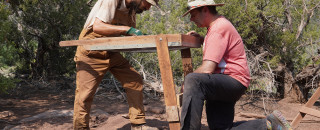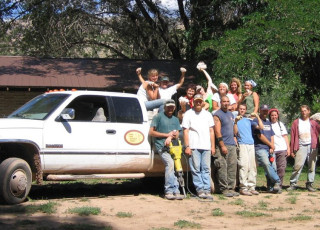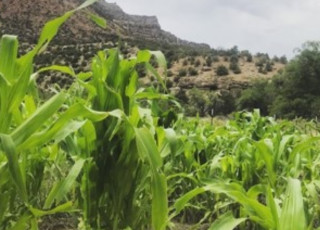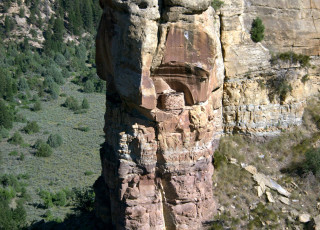My Introduction to Range Creek: A Greater Appreciation for Archaeology
Dr. Jason Cryan on the right assisting Brendan at the Range Creek Field Station. ©NHMU/Credit: Randy Irmis
By Jason Cryan, Ph.D.
Although I joined the remarkable NHMU team more than one year ago, there’s still quite a lot about this Museum and its people that I have yet to learn. And I want to learn it all, I’m 100% in. I can speak effectively for the team only if I understand what this place is and what my colleagues do. Plus, I’ve always loved the sense of discovery when seeing and learning something new.
One of the parts of the Museum that I’ve been eager to see is its remote research station in Range Creek Canyon, approximately four hours southeast of Salt Lake City. Of course, I had been told about the Range Creek Canyon field station and its history, but the COVID-19 pandemic prevented me from visiting the station in person - until now. Finally, after many months of anticipation, the stars aligned and I was able to visit Range Creek for the first time - accompanied by my trusty colleague and NHMU’s Chief Curator, paleontologist Dr. Randy Irmis.
Now, to describe Range Creek as ‘remote’ is a slight understatement. It’s out there. Really far. After leaving the highway south of Price, Utah, the pavement extends only a short distance before you find yourself driving on dirt and gravel. Although the road wasn’t especially rough (at least, not when we drove it), one quickly understands that there’s not much else around for many miles. The first thought that surfaced in my consciousness was that this was no place for a medical emergency. The dirt road winds its way ever higher through Horse Canyon, rewarding passengers with breathtaking views at each switchback turn – not so for the driver, who must remain laser-focused on the road because there are no comforting guardrails to correct any off-course veering (and I did begin to wonder if my paleontologist driver was spending too much time looking out the window for fossils!). Finally, the road tops out at a narrow pass high up between the peaks before descending gently into Range Creek Canyon, which offers similarly magnificent vistas.
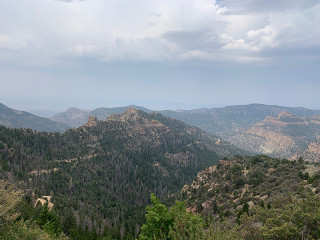
Randy and I met Dr. Shannon Boomgarden, NHMU archeologist and Range Creek Field Station’s director, at the gate to the station’s property on the canyon floor. We abandoned Randy’s nearly-overheated Subaru, hopped into Shannon’s beefy (and delightfully air-conditioned) 4x4 truck with our gear, and promptly learned that we had another 45 minutes of dirt road jouncing in our future before we would finally see the field station proper. However, Shannon artfully stretched that 45-minute drive into a tour of about an hour and a half, stopping at several astounding points of interest that were either visible from the roadway or were accessed with short off-road hikes. Range Creek Canyon, you see, is a veritable treasure trove of archeologically significant sites, with more than 500 documented archaeological features including petroglyphs, rock paintings, granaries, artifacts, and ancient dwellings. These features have been associated with the people of the Fremont period, the earliest known farming culture that inhabited Utah from about A.D. 300 - A.D. 1350.
The rock art (petroglyphs and paintings) that Shannon pointed out to us were remarkable. Some of the art covered entire rock faces – huge panels – while others were individual illustrations or carvings. The imagery seen in this prehistoric graffiti is distinct and evocative, including depictions of humans, animals, abstract shapes, and symbols that were perhaps intended to advertise territoriality. Many of the colors used to produce the rock paintings – 1,000 years ago! – are still preserved with an extraordinary vibrancy that inspires wonder.
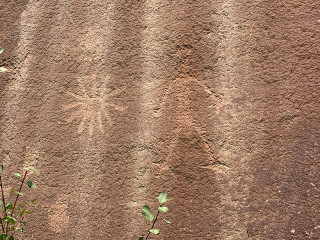
While so many of these prehistoric features were astonishing, what amazed us the most were the granaries – essentially, food storage bins constructed way up high on the cliffs forming Range Creek Canyon. Exactly why the Fremont people chose to tuck their granaries on inaccessible cliff faces isn’t known, it could have been to protect their food resources from human or animal raiders, or perhaps the placement was to advertise their physical prowess (“Look … MY granary is higher than yours!!”). As mystifying as the reasons for them, the placements of these structures are equally as terrifying. I can only imagine the fear inspired by the words “We’re out of corn, time to visit the granary!” Many of these structures are built into the cliff walls so high up that we needed a spotting scope to see them. Baffling.
After marveling at the Fremont sites for a while, we finally arrived at the research station itself, a converted ranch. Having done my own entomological fieldwork at research stations in the tropics around the world, I was ready for anything…I’ve seen everything from primitive stations to modern labs set in rainforests and jungles on several continents. The Range Creek Station didn’t disappoint, offering many of the comforts of home – including, notably, electricity and indoor plumbing--very civilized! Station Manager Corinne Springer greeted Randy and me warmly, setting us up in one of the guest cabins for our stay, then showed us around the station, which includes guest cabins, a small lab/workroom, and the central house/group kitchen. There’s also a tent area, used mostly by student groups who stay at Range Creek during the archaeological field research courses held there in the summers.
I am most impressed by the ‘experimental archaeology’ trials being conducted at Range Creek. Shannon, Corinne, and their assistants build temporary dams in the Creek, diverting the gently flowing water to irrigate experimental plots of corn that they plant and grow under various water stress conditions. And, they do all of that using only the tools presumably available to the Fremont people, 1,000 years ago – they use logs, mud, sticks, and rocks to build the dams and dig the shallow irrigation ditches, and change the daily flow of water into the experimental plots using stones and mud. Amazing. You can read more about this work in another NHMU blog post and in the published research paper.
Fortunately, one of the summer archaeology field courses was in session when Randy and I visited Range Creek, and the group welcomed us to join them for a morning at one of their dig sites, a Fremont ‘pit house’ structure they are excavating. We began working the site at about 8:00am to get a good start before the intense summer sun becomes unbearable. I’ve never experienced archaeological fieldwork before, so I was very excited to try something new. After helping to set up a series of connected sunshades over the site to protect the students actually excavating the pit-house, I decided that I could best contribute to the morning’s efforts by helping one of the Field School’s graduate teaching assistants, Brendan, sift and sort through the excavated buckets of soil and rock, looking for pottery sherds and tiny flakes of chert left behind from prehistoric tool-making. Describing my assistance as ‘helping’ Brendan, however, is generous at best. I mainly carried buckets of dirt to him as he expertly worked the sifting screen – basically, a large rectangular sieve on wooden legs – and then watched as he deftly sorted through the copious matrix material and extracted tiny pieces of interest with a confident expertise resulting from countless hours of hard work. As for me, I’d occasionally see something I KNEW to be archaeologically significant, but inevitably when I’d point these objects out to Brendan, he’d kindly say, “No, just another rock.” Meanwhile, I could hear Randy and Shannon sorting through other excavated material nearby, constantly chattering about the cool pottery pieces they kept turning up.
It was painstaking. It was frustrating. And humbling. But it was a truly fantastic experience, and a great learning opportunity, giving me insight into – and a true appreciation for – archaeological fieldwork.
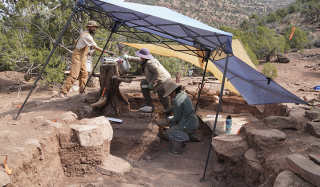
The Natural History Museum of Utah is truly fortunate to be the caretaker of the Range Creek Research Station, and the hundreds of archeologically significant features throughout Range Creek Canyon. Randy and I thank Shannon, Corinne, and the Archaeology Field School participants for their gracious tour and camaraderie in the extreme Utah heat. You can learn more about the Range Creek Research Station, including about how to obtain permits to visit this incredible place yourself, at https://nhmu.utah.edu/range-creek.
Jason Cryan, Ph.D., is a biodiversity scientist and the executive director of the Natural History Museum of Utah. NHMU is part of the University of Utah in Salt Lake City. Our mission is to illuminate the natural world and the place of humans within it. In addition to housing outstanding exhibits for the public, NHMU is a research museum. Learn more.
